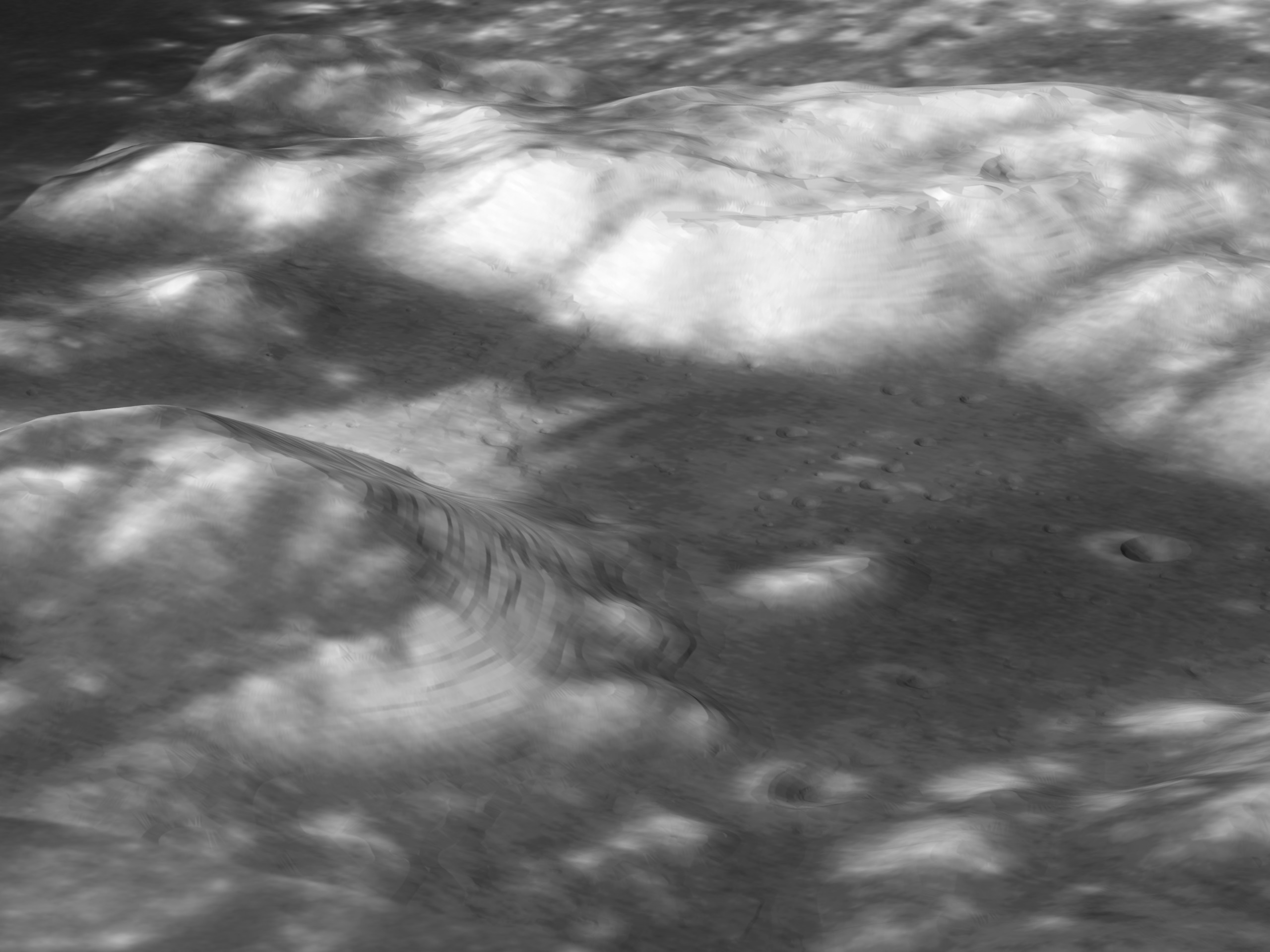Planets and Moons
ID: 3274
The Hubble Space Telescope looked at specific areas of the moon prospecting for important minerals that may aid future sustained human presence on the moon. Initial analysis of the data indicate the likely presence of titanium and iron oxides. These minerals can be sources of oxygen, essential for human exploration.

Hubble Space Telescope Looks at the Moon to Prospect for Resources (Apollo 17 Landing Region)
This visualization starts with a view of the moon as seen from Earth using a USGS Apollo derived artist rendered texture (airbrushed). The camera then zooms into the Apollo 17 landing region using Clementine data (the outer area after the camera pauses), high resolution HST data (the inner area), and Apollo 17 derived topgraphy.
Exposure Time: 2.5 minutes
Filters: F250W (250nm), F344N (344nm), F502N (502nm), F658N (658nm)
Data from these multiple filters were used to produce the mosaic Apollo 17 landing site image.

Visualization Credits
Greg Shirah (NASA/GSFC): Lead Animator
Alex Kekesi (Global Science and Technology, Inc.): Animator
Horace Mitchell (NASA/GSFC): Animator
Greg Bacon (STScI/Aura): Animator
James Garvin (NASA/GSFC): Scientist
Alex Kekesi (Global Science and Technology, Inc.): Animator
Horace Mitchell (NASA/GSFC): Animator
Greg Bacon (STScI/Aura): Animator
James Garvin (NASA/GSFC): Scientist
Please give credit for this item to:
NASA/Goddard Space Flight Center Scientific Visualization Studio Additional credit to Zoltan G. Levay (STScI)
NASA/Goddard Space Flight Center Scientific Visualization Studio Additional credit to Zoltan G. Levay (STScI)
Short URL to share this page:
https://svs.gsfc.nasa.gov/3274
Missions:
Apollo
Clementine
Data Used:
Note: While we identify the data sets used in these visualizations, we do not store any further details nor the data sets themselves on our site.
This item is part of these series:
The Moon
Astrophysics Visualizations
Keywords:
SVS >> HDTV
SVS >> Lunar
SVS >> Moon
SVS >> Astrophysics
SVS >> Apollo Missions
NASA Science >> Planets and Moons
https://svs.gsfc.nasa.gov/3274
Missions:
Apollo
Clementine
Data Used:
Clementine/UVVIS Camera/750-nm Basemap
Mosaic - 1994/02/26-1994/05/05HST/ACS
2005/08/16 - 2005/08/21Apollo 15/Panoramic Camera/Photography Frames 9552, 9557, 9554, 9559
litt_dem.bilDEM of the Littrow area of the Moon in an RAW binary format.
Simple Cylidrical, 1 band.
Arc: describe LITT_DEM
Description of Grid LITT_DEM
Cell Size(deg/pxl)=0.00034049743634 Data Type: Unsigned Int
Number of Rows = 4308
Number of Columns = 4619
BOUNDARY STATISTICS
Xmin = 29.904 Minimum Value = 1420.000
Xmax = 31.477 Maximum Value = 4108.602
Ymin = 19.387 Mean = 2432.915
Ymax = 20.854 Standard Deviation = 630.217
COORDINATE SYSTEM DESCRIPTION
Projection GEOGRAPHIC
Datum NONE
Note: Cell size in projection Sinusoidal is 10 meters/pixel
Note: Null value is 0
litt_dem.bil -> raw image DEM
litt_dem.hdr -> text header file
litt_dem.blw -> text georeferencing world file
litt_dem.stx -> text stats. file
Trent M. Hare
US Geological Survey
thare@flagmail.wr.usgs.gov
(520) 556-7126
Misc notes:
-Compiled by Frank Schafer (USGS) at DMA Houston
-This is a preliminary map before DMA control net was finished
-datum was arbitrarly set
-no specific project applied
frames used for photogrammetry:
Apollo 15 panoramic photography frames 9552,9557,9554,9559
frames used for control:
-Apollo 15 frames 1112, 1113 by using camera orientation data
-scale established from lunar orbiter IV, H-78
Sited in book:
Apollo17 Preliminary Science Report
Clementine and HST/HIRES and the Telescope/Lunar Composite Texture
HST/WFPC2
Wide-Field Planetary Camera 2 (WFPC2) was installed in Dec 1993 and used to obtain high resolution images of astronomical objects. This camera was removed in the last servicing mission so it is no longer in service.
This item is part of these series:
The Moon
Astrophysics Visualizations
Keywords:
SVS >> HDTV
SVS >> Lunar
SVS >> Moon
SVS >> Astrophysics
SVS >> Apollo Missions
NASA Science >> Planets and Moons











